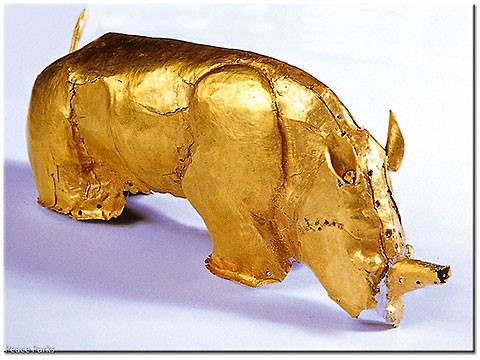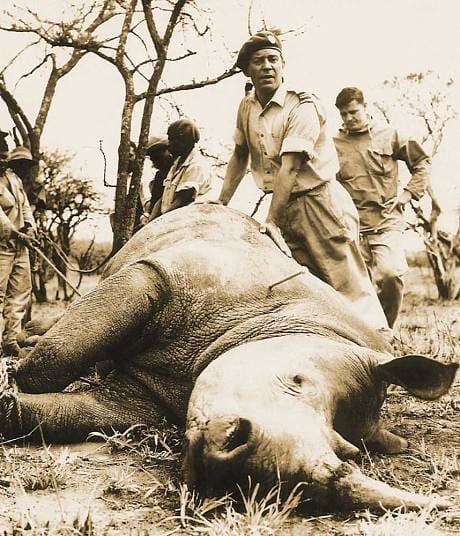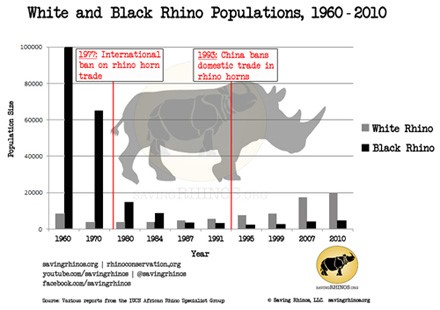African Rhino History
This blog was written by Olivia Pugh.
Rhinos across the continent are facing the threat of extinction due to the actions of humans. Habitat loss and poaching for their horn are the two main causes of their recent decline. Unfortunately, the current poaching crisis isn’t an isolated incident, and the species has been brought to the brink of extinction before. To fully understand today’s poaching crisis it is important to look at the history of the rhino and its interactions with the human race.
The 19th and 20th Century
During the 19th and early 20th centuries, hunting for sport was extremely popular in Southern Africa, and this love of big game hunting took a heavy toll on both the white and black rhino. Though not as badly affected by game hunting, the black rhino did see a steep decline in numbers between the 1950s and 1990s when Africa lost 95% of these animals. The southern white rhino, however, had been hunted in such numbers that by 1895 it was considered extinct. Then a handful of animals, less than 60, were found still surviving in an area which would become South Africa’s Hluhluwe-Imfolozi National Park. It was only the sanctity of a Royal Zulu hunting ground located between the white and black Imfolozi Rivers which kept this gene pool preserved. This is just one example of the cultural connection between these primordial creatures and the peoples of Africa. The 20th-century discovery of the gold-plated rhino at Mapungubwe, provides more evidence of the value that rhinos hold for African cultures.

By the 1960s, the southern white rhino population in Hluhluwe-Umfolozi had grown to over 400 and the Natal Parks Board (the body in charge of Hluhluwe-Imfolozi National Park) realized that it was too risky to have the entire population of white rhinos in one place. Under revered conservationist Dr. Ian Player, ‘Operation Rhino’ was launched. This involved relocating a number of the white rhinos to other safe locations around Africa and to zoos and safari parks around the world. By doing this, the gene pool was spread out and breeding herds of rhino were established. This became the catalyst for the initial growth in the private wildlife industry in South Africa and was hugely effective in enabling the white rhino population to rebound to healthy numbers of around 20,000 individuals by 2010. Sadly, however, this was not to be the rhinos’ only close call with extinction.

Dr. Ian Player with a southern white rhino (Photo Credit: ianplayer.com)
The 1970s and 1980s
By the late 20th century, Africa’s rhinos were facing another battle for their survival. Economic growth in the Middle East, due to the discovery of oil, led to the growth of an affluent middle class in Yemen and with this came a demand for rhino horn. Culturally significant daggers called ‘Janbiyas’ are traditionally crafted with an ornamental handle; the material the handle is made from reflects the status of the owner. Unfortunately, one material that was considered to be of high value was rhino horn. Only the rich could historically afford rhino horn handles, but as Yemen’s economy grew with the oil boom, so did the size and wealth of its middle class, meaning a much larger number of people could afford to buy rhino horn handles. Thus, the demand increased, and as demand increased in Yemen, so too did poaching in Africa. Though there is still some demand from Yemen for rhino horn, this is a fashion which seems to have dropped off in recent decades and accounts for a very small fraction of poaching today.
Current Poaching Crisis
While demand for rhino horn from Yemen has waned, demand from other areas of the world has exploded. From the early 2000s, numbers of poached rhino began to spike dramatically, going from just 13 in 2007 to more than 1,000 a year from 2013 onwards. This drastic increase was due to fresh demand for rhino horn from South East Asia, specifically, countries like Vietnam and China. Rhino horn is an ingredient used in traditional Chinese medicine, said to cure a myriad of ailments such as fever and vomiting, this has been added to by a modern myth that rhino horn can cure cancer. From here its uses have evolved, being used as a hangover cure and party drug, as well as being kept whole to show high status. Although no historical uses refer to any aphrodisiac properties, this rumor is now also being exploited. Much like in Yemen, this demand is largely stimulated by a newly affluent and growing middle class who never had disposable income before. All this is despite there being no scientific evidence that rhino horn has any medicinal properties.

Poaching stats: 2011-2015 (Credit: stoprhinopoaching.com)
There are around 18,000 white and 2,500 black rhinos left in South Africa, which is about 75% of the Earth’s entire rhino population. To help our rhinos back from the current brink will take a concerted global effort, and it is key that everyone stays educated and stays motivated. Rhinos have come back from the brink of extinction twice before, and if we work as a global community they can do it again.

Further Links:
Operation Rhino: http://www.hluhluwegamereserve.co.za/save-the-white-rhino/
Rhino Stats: www.stoprhinopoaching.com





